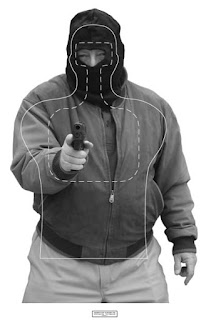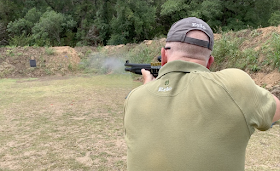 |
| The First Shot--Notice the Bad Guy is Aiming at the Officer |
In
the original article I mentioned research from Vickers and Lewinski who
discovered that more experienced police officers placed their hand on
their pistol and often drew their pistol earlier in a confrontation and
thereby gained precious time in responding to a threat—often shooting
before the threat could fire at them. **
In the video below, a police officer in Uruguay does exactly that. As he is sitting eating ice cream, he notices two men approaching and obviously triggers on them for some reason--he immediately obtains a firing grip on his concealed pistol. As one of the perpetrators begins to draw a pistol, an instant later the police officer starts to stand and begins drawing his pistol as well.
The armed perpetrator initially holds his pistol at his side; however, suddenly realizing his erstwhile victim is drawing a pistol the perpetrator brings his own pistol into a firing position aiming at the police officer. Unfortunately for the perp, the officer completes his draw and fires .04 seconds later, before the perp could pull his own trigger. The total time from the police officer initiating his draw to his first shot was 0.73 seconds. As an aside, the officer either missed with the first shot or the bullet went through the perp. You can see the bullet strike the wall behind the perp in the lower left corner of the screen.
The Vickers and Lewinski research prompted me to collect data to determine how much of a time advantage you can gain through placing your hand on the pistol versus starting with your hands in some other location (e.g. hands at sides). My goal was to determine how long it took a competitor (granted, not necessarily the average private citizen licensed to carry) to draw and fire single shot from different starting positions.
We have now timed the draws of 362 individuals over a period of several years during our local IDPA and Sensible Self Defense Short Range matches. We have measured 2458 specific instances of drawing the pistol and firing a shot from concealment, 1627 draws with the pistol not concealed, and 1349 instances when the competitor started with their hand on the holstered pistol. We only included instances where the competitor's shot stuck inside the -1 or 0 of the standard IDPA target or the Shootsteel target in the data set.
The skill level of the competitors has varied from new shooters participating in their first practical match, Novices, Marksmen, Sharpshooters, Experts, and two Masters--unfortunately we have few Master class shooters in our local matches.
We have discovered that for all experience levels, placing your hand on a concealed or openly carried pistol early in a dangerous situation can provide a 0.75 to 1.75 second time advantage (depending on the individual skill level) if you must draw compared to starting with the hands in some other position. This is not trivial—3/4th of a second to 1-3/4 seconds faster can be a lifetime in a deadly confrontation as we saw in the video.
If the police officer had started his draw from a neutral position without his hand on the pistol, it is highly probable that the perpetrator would have fired first—four one-hundredths of a second is 2.5 times faster than the average human eye can blink.
Trying to draw a pistol in a “Stand and Deliver” response to a criminal’s drawn pistol is a great way to get shot if the criminal is committed and paying attention. In an experiment we conducted in 2016 we found that even when the good guy had the initiative, in 98 out of 100 trials the bad guy fired first. We had one tie where both the good and the bad guy fired simultaneously and one instance where the good guy fired first.
Does Stand and Deliver work? Sometimes. If you time your response or if the get inside the bad guy's decision cycle, a Stand and Deliver response can work as we saw in this incident.
If you enjoy reading these please subscribe. The link is on the upper right side of the page. All that will happen is that you will receive an e-mail when I post an article. Your information will never be distributed.
Come out and shoot with us on the second Sunday of every month at Cedar Ridge Range in San Antonio, Texas.
For more information go to: www.sensibleselfdefense.com
*
Is placing your hand on a holstered pistol a violation of the law as
long as the pistol remains in the holster? I’m not a lawyer and this is
not legal advice; laws vary by state—check your local laws as
appropriate.
**You can find this article on the Force Science website at:
https://www.forcescience.org/2009/10/major-new-study-how-your-eyes-can-cast-your-fate-in-a-gunfight-part-1/

























